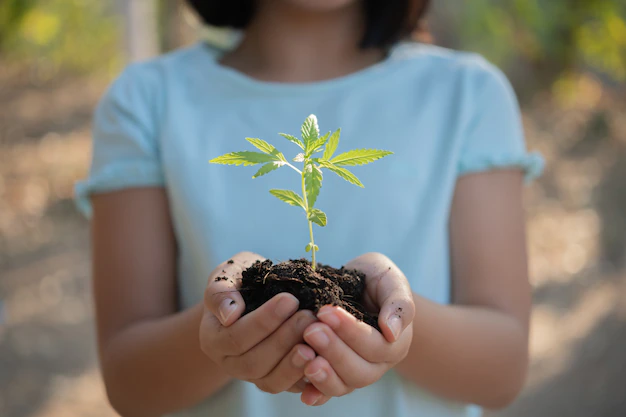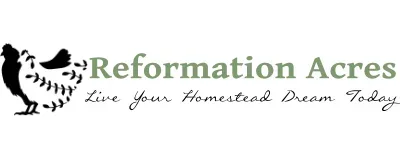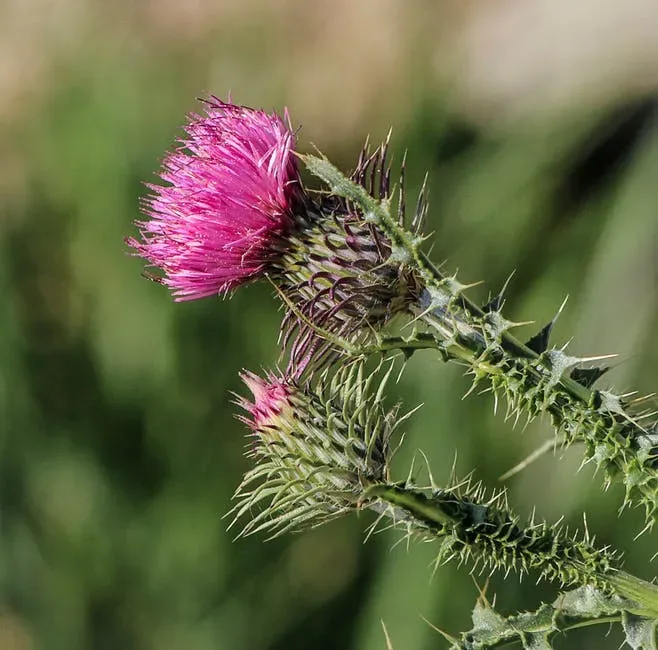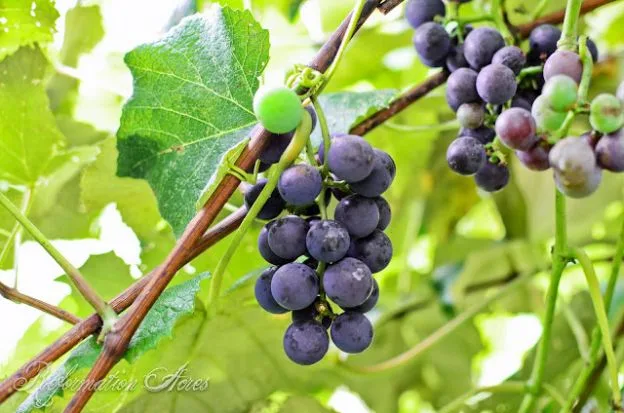Why Pull Weeds? 11 Reasons to Weed Your Garden
Pulling weeds can be a pain. Literally. (And if you’re dealing with thistle, it’s more than a pain, it’s a nightmare.) It’s a drain on your time and energy. Is it even worth it to pull weeds?
I’m seeing more and more folks embrace a “permaculture” perspective on garden weeds. After all, weeds can be useful. Chickweed, plantain, purslane, dandelion, lamb’s quarter, and more are used for food and medicine. Why not leave them to grow up alongside your garden crops and increase the bounty? Why bother to pull weeds at all?

I’ll admit it. It’s a very tempting solution to a continuous garden problem!
In the end, I’m going to pull the weeds in my garden despite the perceived benefits. I have 11 good reasons why we should pull weeds.

Check out this clip of my all-time favorite weeding tool!
11 Reasons to Weed Your Garden
Here are the reasons why you need to weed your garden.
1. Weeds Compete with Your Food
Imagine we’re all sitting around the dining room table, about to enjoy a really great home-cooked meal together. The food is warm and the fellowship even warmer. Everything looks bright, fresh, and delicious. It’s looking like you’re going to bed with a full belly tonight! And then some uninvited guests show up. They smelled the good food wafting in their window. They know you’re of a hospitable nature and won’t turn them away from a meal. Oh, and they brought their extended family with them. Forget your full belly, now you’re wondering if there is going to be enough food to go around. Rightly so because the pickings are slim, and food isn’t just going to multiply with the guests.
This is a lot of what it’s like when weeds show up in your garden. The soil is full of nutrients for the plants to use along with the sun and rain to grow. It’s a smorgasbord. But soil biology can only transport them so far. Every plant has to share its meal with its neighbors. The fewer neighbors that show up, the more nourishment there is for the plants. This will, in turn, means healthier, more nutrient-dense produce on your table, for your family. (And your guests.)
This is also why you need to be careful when intensively growing your vegetables in small spaces. If you need to be intentional about growing crops too close together, how much more so when we’re talking about uninvited crops?
When you allow weeds to grow up alongside your vegetables they compete with your food for food and your cultivated plants won’t be as productive and nutritious as they could be.
2. Weeds Block Out Sunlight and Steal Water
Not only do weeds compete with your crops for nutrients in the soil, but they compete for sunlight and water as well.
It’s no secret that weeds seem to grow more aggressively than the plants you carefully tucked into the soil. When weeds grow faster than your vegetables, they begin to block out the sun that your garden plants need to thrive.
Weeds can also create micro-climates that cause your plants to be too cool in the mornings and evenings, or in the early & late seasons. While this technique can be used to your advantage when planning your garden layout, being intentional about it is different than allowing it to happen where you didn’t necessarily want it to.

The precious resource of water is so beneficial to the growth of your garden, just like the nutrients in the soil have limited availability, and what the weeds “drink” leaves less water available for the plants you’ve cultivated.
3. Weeds Crowd Out Your Crops Space
Each plant that grows in your garden, whether weed or crop, has a root zone. It’s like its personal space and they don’t take kindly to having their personal space invaded. When the root zone of one plant shares space with another plant the plants become stressed, unhealthy and susceptible to pressures from pests and diseases. The root zone of a tomato plant can grow to over 5 feet! In our heavy clay soils when those roots run out of room to go down easily, they begin to go out. In that 5 square feet around a tomato plant, I often have other tomato plants, maybe some undersown greens as well. If we don’t pull weeds and they are allowed to flourish, they are not only competing for real estate above the soil but below it as well.
4. Weeds Hide Your Crop
For some vegetables we grow, like summer squash, it’s difficult to find the crop buried under the leaves. When you allow the weeds to grow up, the problem is multiplied and your harvest may be buried under the weeds that have been allowed to grow up.
Of course, that’s if they grew in the first place.
Weeds will crowd out garden fruits from your view, and block their flowers from the sight and scent of the pollinators that cause fruit to set or other beneficial insects that might have been attracted to your garden. If the weeds are too abundant and attractive to pollinators, they could actually curb the pollination of the cultivated crops because the pollinators have an adequate food source in the flowering weeds.

5. Weeds Camouflage Pests and Diseases
Weeds hide your precious crop when you are making your harvest. But they could also be hiding the symptoms of pests and diseases that will stress the plants and decrease the yields. Through quick identification and action, many of these problems could be nipped in the bud before they become larger problems.
When dealing with squash bugs in the garden for example your best offense is the quick identification and elimination before eggs ever get a chance to hatch. I have a cheap and easy trick for killing squash bugs that would never work if the zucchini or cucumbers or pumpkins were growing in a jungle of weeds.
6. Pulling Weeds Gives You a Reason to Be in Your Garden
Between the sowing season in early spring and the beginning of the harvest weeks later, a nonchalant weeding plan doesn’t give you much of an excuse to be in the garden. This is a critical time that you could miss out on cues of problems with your plants. When you pull weeds it gives you a chance to study and make mental notes of what is going on with life in your garden. You can observe successes, catch potential failures, learn to identify pests or beneficial insects, and cultivate your best garden.
7. Weeds Can Create a Habitat for Pests to Overwinter
If weeds are left to overwinter in the garden, many pests will make that habitat their home during the cold winter months. That shelter is great news for them. They won’t have to look far when searching for their favorite host plants in the spring. But it’s bad news for you because such a pest-friendly environment spells disaster for your next year’s garden. Nothing like setting yourself up for failure.

8. Crop Diseases
Weeds can carry diseases that can be passed from the weed to your crops by insects feeding first on the weeds, particularly insects that feed by sucking plant juices such as aphids.
9. Weeds May Contain Allelopathic Compounds
Certain weeds, such as lamb’s quarter, thistle, and pigweed may contain allelopathic compounds. They can create a zone of infertility around their roots. This is so they can take full advantage of the sun, water, and nutrients that the space they are occupying has to offer. Or they can inhibit the germination of the seeds altogether and create an inhospitable environment for growth. (This is one of the reasons why some cover crops work so well.) Infertility may impact this season or the next, which is one reason why crop rotation in the garden is important- some crops, such as brassicas, have allelopathic actions on successive crops planted in the same space.
10. Weeds Are a Problem That Will Only Get Worse
Several successions of weeds can grow to maturity and go to seed before your garden is through producing in the fall. One plant of lambs quarter can have over 75,000 seeds! Chickweed averages 25,000 seeds per plant which makes thistle seem like no problem at all with “only” 2,000 seeds. (The thought of 2,000 more thistles in the garden makes me want to cry.) Each dandelion flower is capable of producing 150-200 more dandelion plants. How many seeds did you drop from the packet into the soil this year? You do the math. Let your weeds go and you don’t stand a chance.
There are many incredibly useful and beneficial weeds for food, ground cover, pollinator attractants, and more. But the trouble is that most of those weeds aren’t easy to identify as seedlings. That happens to be the easiest and best time to pull weeds. Unchecked, the weeds we could use for food and medicine could end up causing more garden problems than they’re worth.
11. It Can Be Therapeutic to Pull Weeds
At least for me, it is. Total introvert here and when I pull weeds it gives me some meditative, yet productive, alone time. Or a chance to catch up on my favorite podcasts while making my garden a more beautiful space! Because nobody’s volunteering to lend a hand. If a chatty kid hangs out too long all I’ve got to do is suggest they might as well help out while they’re talking and, well, that ends that.
Conclusion
Why is weed eradication so essential? Almost all weeds are unpleasant. That much is visible, and it is reason enough to get rid of weeds on its own. But above all, weed growth should be kept to a minimum for significant practical reasons. Although it comes with it’s own process, planting a winter vegetable garden has the benefit of no weeds. It is something to consider trying.
Do you like to pull weeds?





